Installation and Upgrade
Installing the Driver for Delimited Text
You can install the Driver for Delimited Text along with other DirXML drivers at the same time that the DirXML engine is installed. This method of installation is documented in the DirXML Administration Guide.
Also, you can install the driver separately, after the DirXML engine is installed. The following sections explain how to install the driver separately.
Installing to Windows
-
Run the DirXML installation program by inserting the Identity Manager 2.0 CD.
If the installation program doesn't autolaunch, you can run \nt\install.exe.
-
In the Welcome dialog box, click Next, then accept the license agreement.
-
In the first DirXML Overview dialog box, review information, then click Next.
The dialog box provides information on the following:
- DirXML Driver
- DirXML Connected Server System
-
In the second DirXML Overview dialog box, review information, then click Next.
The dialog box provides information on the following:
- Web-based Administration
- DirXML Utilities
-
In the Please Select the Components to Install dialog box, select only DirXML Server, then click Next.
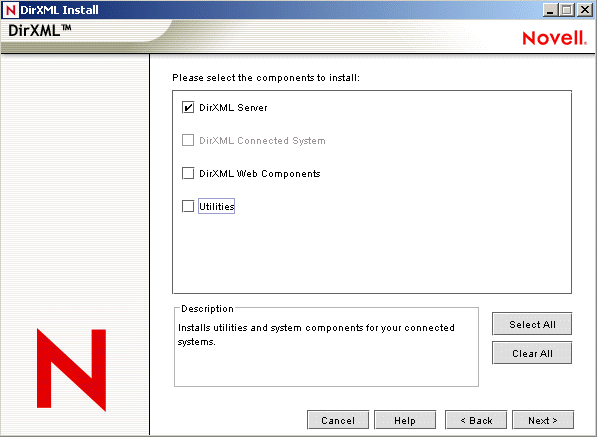
-
In the Select Drivers for Engine Install dialog boxes, select only Delimited Text, then click Next.
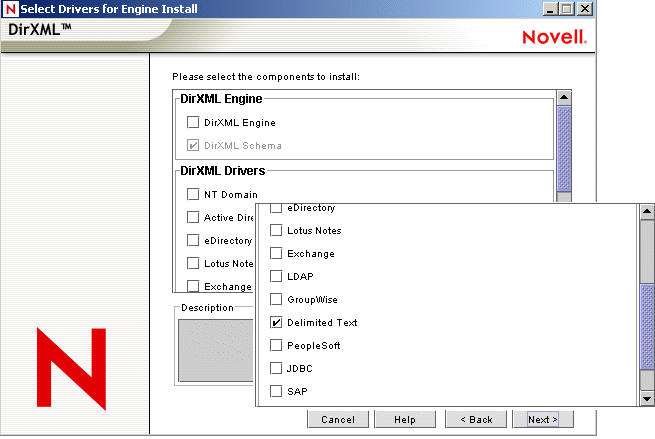
You can't deselect DirXML Schema, which is grayed out. Later, the installation program will extend the schema, to enable the newly installed driver to function.
-
In the DirXML Upgrade Warning dialog box, click OK.
-
In the Schema Extension dialog box, type a username and password, then click Next.
-
In the Summary dialog box, review selected options, then click Finish.
-
In the Installation Complete dialog box, click Close.
After installation you must configure the driver as explained in Setting Up the Driver.
Installing to NetWare
-
At the NetWare server, insert the Identity Manager 2.0 CD and mount the CD as a volume.
To mount the CD, enter m cdrom.
-
(Conditional) If the graphical utility isn't loaded, load it by entering startx.
-
On the graphical utility, click the Novell icon, then click Install.
-
At the Installed Products dialog box, click Add.
-
At the Source Path dialog box, browse to and select the product.ni file.
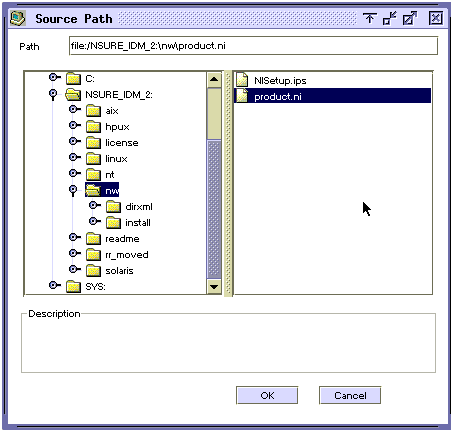
-
At the Welcome dialog box, click Next, then accept the license agreement.
-
At the DirXML Install dialog box, select only DirXML Server, then click Next.
Deselect the following:
- DirXML Web Components
- Utilities
-
At the Select Drivers for Engine Install dialog box, select only Delimited Text.
Deselect the following:
- DirXML Server
- All drivers except Delimited Text
-
At the DirXML Upgrade Warning dialog box, click OK.
The dialog box advises you to activate a license for the driver within 90 days.
-
At the Schema Extension dialog box, type a username and password, then click Next.
-
At the Summary screen, review selected options, then click Finish.
-
Click Close.
After installation you must configure the driver as explained in Setting Up the Driver.
Installing to Linux or Solaris
By default, the DirXML Driver for Delimited Text is installed when you install the DirXML engine. In case the driver wasn't installed at that time, this section can help you install it.
As you move through the installation program, you can return to a previous section (screen) by entering previous.
-
In a terminal session, log in as root.
-
Insert the Identity Manager 2.0 CD and mount it.
Typically, the CD is automatically mounted. To manually mount the CD:
Platform What to Type Red Hat
mount /mnt/cdrom, then press Enter
SuSE
mount /media/cdrom, then press Enter
Solaris
mount /cdrom, then press Enter
-
Change to the setup directory.
Platform Path Red Hat
/mnt/cdrom/linux/setup/
SuSE
/media/cdrom/linux/setup/
Solaris
/cdrom/solaris/nsure_idm_2/setup/
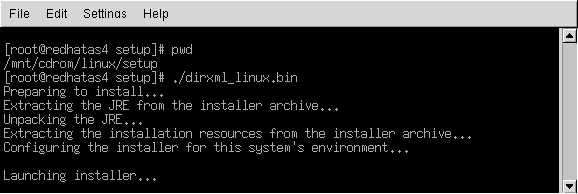
-
Run the installation program by typing ./dirxml_linux.bin.
-
In the Introduction section, press Enter.
-
Accept the license agreement.
Press Enter until you reach the Do You Accept the Terms of This License Agreement prompt, type y, then press Enter.
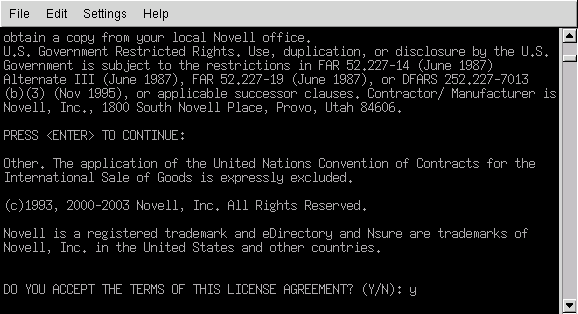
-
In the Choose Install Set section, select the Customize option.
Type 4, then press Enter.

-
At the Choose Product Features section, deselect all features except Delimited Text, then press Enter.
To deselect a feature, type its number. Type a comma between additional features that you deselect.

-
In the Pre-Installation Summary section, review options.

To return to a previous section, type previous, then press Enter.
To continue, press Enter.
-
After the installation is complete, exit the installation by pressing Enter.
After installation you must configure the driver as explained in Setting Up the Driver.
Upgrading the Delimited Text Driver
To upgrade your DirXML Driver for Delimited Text, run the Identity Manager 2 installation program and select the DirXML Driver for Delimited Text. You can do this at the same time that you install the engine or you can do it after the engine is installed.
The new driver replaces the previous driver. Because your previous driver configuration is preserved, no post-installation configuration is required. However, you must restart the driver.
重要: The sample configuration file for the updated driver has changed for this release of DirXML. If your current configuration meets your requirements, you don't need to import this sample configuration. If you do import the new sample configuration, you will see an additional driver for Delimited Text with a new name, a new eDirectory container specified in the placement rule, and new rule names.
Setting Up the Driver
If you are upgrading an existing driver, setup is not required.
If this is the first time the Delimited Text driver has been used, complete the post-installation tasks in the following sections:
- Configuring the Driver
- Preparing Data Locations
- Starting the Driver
- Migrating and Resynchronizing Data
- Activating the Driver
Configuring the Driver
In iManager, complete the following steps:
-
Select DirXML Utilities > Create Driver.
-
Select a driver set.
If you place this driver in a new driver set, you must specify a driver set name, context, and associated server.
-
Mark Import a Preconfigured Driver from the Server and select the DelimitedTextCSVSample.xml.
The driver configuration file is installed on the Web server when you set up iManager.
-
Click Next.
You will be prompted for the following information:
-
Click Finish.
注: You can configure and modify the driver's other parameters. For more information, refer to Configuring Driver Parameters.
Preparing Data Locations
If you use all of the defaults provided by the sample configuration, prepare locations for DirXML data:.
-
Add the containers Users\Active at the root level of your eDirectory tree.
-
On Windows, create the following two directories on your local file system:
- c:\cvsample\input
- c:\cvsample\output
On Solaris, Linux, or NetWare, create input and output directories wherever you'd like. Then update the driver configuration with the correct platform-specific paths. For more information, refer to Source File Path in the Publisher Settings section. (See Publisher Settings).
Starting the Driver
If you changed default data locations during configuration, ensure that the new locations exist before you start the driver.
-
In iManager, select DirXML Management > Overview.
-
Locate the driver in its driver set.
-
Click the driver status indicator in the upper right corner of the driver icon, then click Start Driver.
Synchronization takes place on an object-by-object basis as changes are made to individual objects. If you want to have an immediate synchronization, you must initiate that process as explained in Migrating and Resynchronizing Data.
Migrating and Resynchronizing Data
DirXML will synchronize data as it changes. If you want to synchronize all data immediately, you can do one of the following:
- Migrate new data into or from eDirectory.
- Resynchronize existing data by using the driver set Properties page.
The Migrate and Synchronize options usually behave independently of any driver. However, some issues exist with these options and the DirXML Driver for Delimited Text.
The following figure illustrates the Migrate and Synchronize options:
Migrating Data from eDirectory
To find eDirectory entries that do not have a DirXML association for the driver, click Migrate from eDirectory. Non-associated entries that are not vetoed by rules processing will be written to the output file and will receive an association.
注: Entries that already have up-to-date associations will not be written to the output file. To output all associated entries, click Synchronize.
Migrating Data into eDirectory
With most DirXML drivers, migrating into eDirectory causes the DirXML engine to query the application through its driver. The query finds entries that can be synchronized from the application into eDirectory. These synchronized entries are created in eDirectory. The driver assigns an association value to each new entry.
The Migrate into eDirectory option has no function when used with the DirXML Driver for Delimited Text. This driver gets all of its input as files are placed in the input directory. Because the driver is always up-to-date concerning the files it processes, you don't have to do any additional processing or querying. If you do click Migrate into eDirectory, nothing will happen because queries are disabled with this driver.
Synchronizing Data
When entries in eDirectory have an association with the selected driver, the Synchronize option causes those entries to synchronize again with the associated entries in the application. If the driver has a Subscriber channel, eDirectory is considered to be the authoritative source for the attributes in the Subscriber filter.
The DirXML Driver for Delimited Text can't query the application directly to determine what is out of sync. Therefore, the DirXML engine sends a Modify event to the driver for each associated entry. This event causes each of these entries to be written to an output file whenever you click Synchronize. If no Subscriber is configured, Synchronize will have no effect with the driver.
To use Migrating from eDirectory, Migrating into eDirectory, or Synchronize:
Activating the Driver
You must activate DirXML and DirXML drivers within 90 days of installation. Otherwise, they will shut down. At any time during the 90 days, or afterward, you can choose to activate DirXML products to a fully licensed state.
To activate your driver:
- Purchase DirXML licenses
- Generate a Product Activation Request
- Submit the Product Activation Request
- Install the Product Activation Credential received from Novell
For more information about completing these tasks, refer to Activating Your DirXML Product.